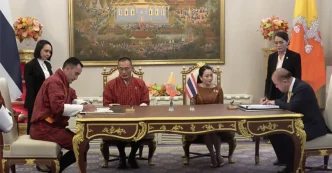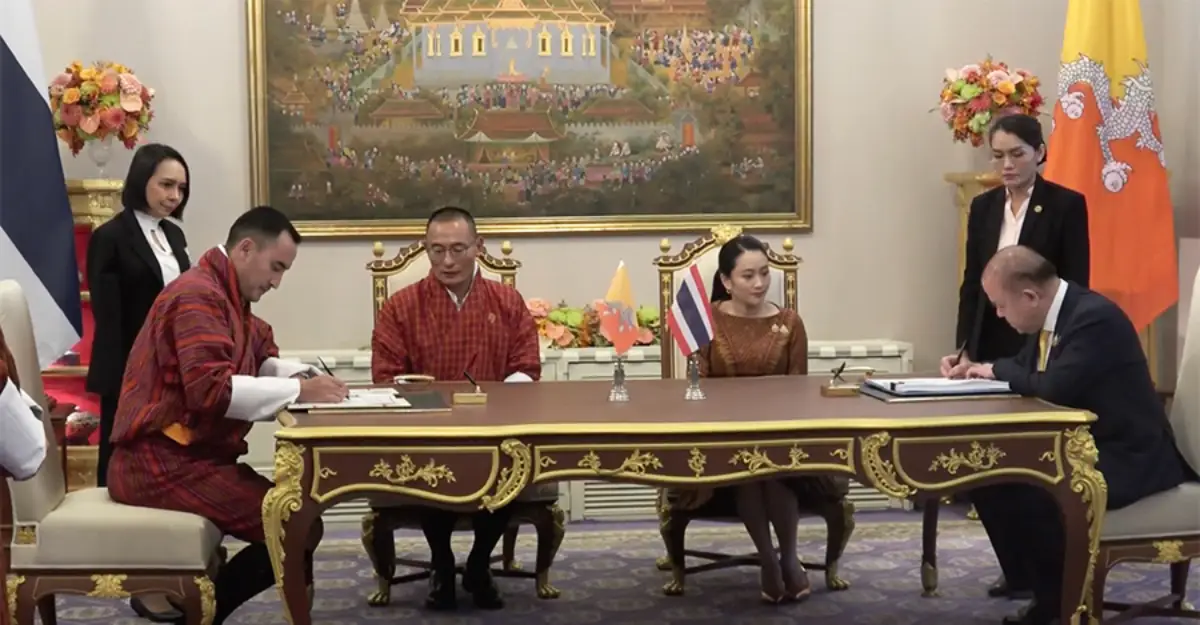A landmark Free Trade Agreement (FTA) between the Kingdom of Bhutan and the Kingdom of Thailand, slated for implementation by January 2026, promises to reshape economic relations between the two nations. Approved by Bhutan’s National Assembly on June 20, 2025, and now under deliberation in the National Council, the deal is poised to grant Bhutanese exports duty-free access to the Thai market, a move expected to enhance competitiveness and narrow longstanding trade imbalances. With Thailand eliminating tariffs on 94 percent of its tariff lines and Bhutan reciprocating fully, the agreement marks a significant step toward deeper economic integration.
A Boost for Bhutanese Exports
The FTA offers Bhutan a rare opportunity to expand its export base, particularly for agricultural and specialty products. Goods such as essential oils, cordyceps, apples, spices, honey, pickles, tea, alcoholic beverages, and potatoes—currently burdened by tariffs ranging from 5 to 60 percent—will soon enter Thailand at zero duty. This tariff elimination covers all 131 export-potential products identified by Bhutan’s private sector, alongside 138 of 165 proposed products qualifying for duty-free access under a relaxed 30 percent local content requirement.
Thailand has also introduced a Country-Specific Quota (CSQ) for 11 sensitive agricultural products on its protected list, allowing Bhutan to export specified volumes duty-free. These include 20,000 metric tonnes of potatoes, 130 metric tonnes of garlic, 250 metric tonnes of tea, 10 metric tonnes of coffee, and 25 metric tonnes of trout across 77 tariff lines. Such quotas, which may be revised based on Bhutan’s production capacity, aim to balance market access with Thailand’s domestic agricultural protections.
For Bhutan’s nascent ferro alloy industry, Thailand has lowered the rule-of-origin requirement from 40 percent to 30 percent for seven key iron and steel products, easing export conditions. These measures collectively signal a tailored approach to support Bhutan’s smaller economy while fostering bilateral trade.
Narrowing the Trade Gap
Bhutan has long grappled with a trade imbalance with Thailand, one of its top ten trading partners. The FTA is seen as a critical tool to address this disparity, alongside reducing the nation’s broader current account deficit. By gaining access to Thailand’s market—bolstered by its membership in the Association of Southeast Asian Nations (ASEAN)—Bhutan could potentially tap into wider regional opportunities, amplifying the agreement’s impact.
Beyond tariff reductions, the FTA includes simplified trade procedures and a chapter on economic and technical cooperation. Sectors such as renewable energy, education, investment, intellectual property, and tourism are earmarked for collaboration, laying the groundwork for sustained partnership. The inclusion of a dispute settlement mechanism and an evolutionary clause further ensures the agreement can adapt to future needs, potentially encompassing services and investment.
Parliamentary Perspectives and Public Concerns
During deliberations in Bhutan’s National Assembly, the agreement received broad support for its potential to liberalize trade and strengthen economic ties. Chairperson of the Human Rights and Foreign Relations Committee, MP Damche Tenzin, emphasized its goals, stating, “The agreement aims to enhance exports, liberalize trade, strengthen cooperation, and improve economic efficiency.” He also noted the flexibility of the deal, with no fixed validity period and provisions for amendments as needed by both nations.
However, not all reactions were unequivocally positive. MP Tashi Tenzin of Radhi-Sakteng raised concerns about the consumer impact of duty exemptions on 5,867 imported goods from Thailand. “If illegal practices arise or consumers are not benefited, how is the government prepared to intervene and closely monitor the situation?” he questioned. He underscored the importance of ensuring that tariff exemptions on imports translate into tangible benefits for Bhutanese consumers.
In response, Minister for Industry, Commerce and Employment Namgyal Dorji clarified that goods imported from Thailand would be exempt from customs duty, Goods and Services Tax (GST), and excise tax. “Besides having many preparations to implement the agreement, the Government is fully committed to its execution, with the Competition and Consumer Affairs Authority overseeing the process” said the Minister. He also sought to dispel fears of import surges, asserting that the FTA would balance imports and exports rather than exacerbate disparities.
Strategic Implications for Regional Ties
The Bhutan-Thailand FTA represents more than a bilateral trade deal; it is a strategic milestone in Bhutan’s external economic relations. Thailand’s role as a gateway to ASEAN offers Bhutan a foothold in a dynamic regional market, potentially paving the way for broader economic integration. The agreement’s focus on technical cooperation also suggests a framework for long-term political and diplomatic collaboration, reinforcing ties between the two kingdoms.
For Thailand, the FTA aligns with its broader policy of fostering economic partnerships in South Asia, complementing existing agreements within ASEAN. By offering Bhutan preferential access and quotas, Thailand positions itself as a supportive partner to smaller economies, enhancing its regional influence. The deal could also serve as a model for future agreements with other South Asian nations, signaling Thailand’s commitment to inclusive trade policies.
Challenges and Future Outlook
Despite the optimism surrounding the FTA, challenges remain. Bhutan’s export base is narrow and heavily concentrated in a few sectors, limiting its immediate ability to capitalize on newfound market access. Sustained efforts in product diversification, quality enhancement, and market readiness will be essential to maximize benefits. Additionally, short-term trade imbalances may persist as Bhutan ramps up its export capacity, a concern echoed in parliamentary debates.
Analysts suggest that Bhutan must invest in infrastructure and capacity-building to meet Thai market standards, particularly for agricultural products under the CSQ. The government’s commitment to monitoring consumer impacts through the Competition and Consumer Affairs Authority will also be critical in addressing potential issues arising from increased imports.
On the Thai side, the agreement reflects a balancing act between opening markets and protecting domestic agricultural interests. The quotas for Bhutanese products, while generous, are carefully calibrated to minimize disruption to local farmers. Future revisions to these quotas could hinge on diplomatic negotiations and Bhutan’s ability to scale production without compromising quality.
Economic and Cultural Synergies
Beyond trade, the FTA underscores shared cultural and historical ties between Bhutan and Thailand, both of which value Buddhist traditions and sustainable development. Tourism, a key sector in the agreement’s cooperation chapter, could see mutual benefits as Bhutan’s unique cultural offerings attract Thai visitors, while Thailand’s established tourism infrastructure draws Bhutanese travelers. Joint initiatives in renewable energy also align with both nations’ commitments to environmental sustainability, offering a platform for innovation exchange.
The agreement’s long-term success will depend on how effectively both countries translate these synergies into actionable outcomes. For Bhutan, the FTA is a chance to diversify its economy beyond hydropower and tourism, sectors that dominate its current export profile. For Thailand, it reinforces a leadership role in regional trade diplomacy, building goodwill with smaller neighbors.
As the Bhutan-Thailand Free Trade Agreement moves toward implementation in 2026, its potential to transform economic ties is clear, yet tempered by the need for strategic planning and adaptability. Whether it will fully bridge trade gaps or inspire broader regional cooperation remains an open question, one that stakeholders on both sides will watch closely in the coming years.















